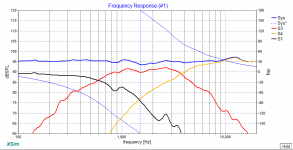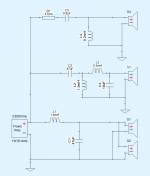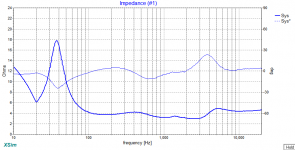Hi, i'm looking for my new home tower speaker setup.. and i wish to share with you my project
my choice drop to these SBacustic Speakers
2x Woofer SB20PFCR30 ( 8 ohm paired parallel)
1x Midrange/Fullrange SB12MNRX2 (4 ohm)
1x Tweeter SB29RDNC-C000-4 (4 ohm)
box design about H:80/W:26/D:30 (centimeters)
the tower will be completed with a pair of 8'' active subwoofer. and i'm currently undecided about saled vs vented box for this 3-way setup...
i wish to share with you my "theorical" test with Xsim , i can't find other tools to simulate speaker box baffle with speaker position.. maybe someone can help.
x-over pretty simple, 12db/oct , midrange phase reverse and total Z about good in most of range.
in attach some pics..
any advice are very appreciated.
Thanks
P.s. FRD and ZMA files are created by manufactured datasheet, i can't measure them myself. if someone need it ask me.
my choice drop to these SBacustic Speakers
2x Woofer SB20PFCR30 ( 8 ohm paired parallel)
1x Midrange/Fullrange SB12MNRX2 (4 ohm)
1x Tweeter SB29RDNC-C000-4 (4 ohm)
box design about H:80/W:26/D:30 (centimeters)
the tower will be completed with a pair of 8'' active subwoofer. and i'm currently undecided about saled vs vented box for this 3-way setup...
i wish to share with you my "theorical" test with Xsim , i can't find other tools to simulate speaker box baffle with speaker position.. maybe someone can help.
x-over pretty simple, 12db/oct , midrange phase reverse and total Z about good in most of range.
in attach some pics..
any advice are very appreciated.
Thanks
P.s. FRD and ZMA files are created by manufactured datasheet, i can't measure them myself. if someone need it ask me.
Attachments
What about response phase?
Attachments
The problem with a test like this is that it doesn't tell you anything, since you can make the curves fit no matter what they look like, even when they don't fit acoustically."theorical" test with Xsim
Since you can't measure, we can break it down. For example what about the baffle step? What about physical offsets? How do you decide where to cross and how?
thanks for reply, sincerly i don't understand what you mean.. and what im wrong. If you mean physica offset on baffle design.. i can show you a draw .. but as most of project tower 3way have classic layout, i don't teach you more than that...
Similar. Phase will vary because they start in a different place. Best is to measure.If you mean physica offset on baffle design..
If you can't measure then you can guess. Where is the voice coil?
@fabio323ti - Are you planning on making acoustical and impedance measurements of your drivers after they are installed in the cabinet? Hopefully yes. Without good measurements, it is very difficult to achieve a good sounding speaker.
j.
j.
Ok i can install driver inside cabinet, create xover and after measure it.... and what so on?@fabio323ti - Are you planning on making acoustical and impedance measurements of your drivers after they are installed in the cabinet? Hopefully yes. Without good measurements, it is very difficult to achieve a good sounding speaker.
j.
Fine tuning xover will find best results? i don't guess will be possible tune phase with xover tune...
speaker positioning require time and a lot of woods material and works.
use simulator tools? what you're advice?
Last edited:
Read this thread, it will help you get started
https://www.diyaudio.com/community/...-design-your-own-speaker-from-scratch.332688/
Since you have already selected your drivers, the next step is to design a cabinet. There are two competing design goals, one is the cabinet's effect on bass response, and the other is the baffle layout and how it affects the radiation of the drivers.
1) I would use VituixCad to design the baffle. This means the height and width of the baffle, the size and spacing of the drivers, and the size/shape of the edge bevel/radius. At this step you will assume the drivers are "perfect pistons", and the crossover will be a hypothetical filter using idealized slopes and eq's.
2) Next you would try to design a box volume and box shape that incorporates your baffle design, and also provides the correct box volume for the woofers. If it is a vented box system, you will also need enough room in the cabinet for a vent. You should assume that the midrange will need 4 - 6 liters of box volume for itself.
You will probably have to go back and forth between steps 1) and 2) until you get the best compromise.
3) Build your cabinets. Some people build a single prototype cabinet from cheaper materials and do all their development work with it. Others accept the risk and go straight to a pair of final cabinets. You will have to decide how confident you are in your design.
4) After you install the drivers in the cabinets, make acoustical and impedance measurements of the drivers. At this point there is no crossover. For best results, you will make horizontal polar measurements from 0 to 180 degrees for each driver. The gated far field measurements are merged with near field measurements to get a composite response that is used in simulation.
5) Begin simulation using the measured impedance and the measured composite responses. Now is the point where you design your crossover.
6) When you are happy with the crossover, order the parts and build it. Remember to order some extra parts, particularly resistors, so you can fine tune the finished crossover.
7) Build the crossovers, install in the speaker, and test the final system. Listen, measure, listen again... tweak if necessary.
Broadly speaking, this is your path to success.
j.
https://www.diyaudio.com/community/...-design-your-own-speaker-from-scratch.332688/
Since you have already selected your drivers, the next step is to design a cabinet. There are two competing design goals, one is the cabinet's effect on bass response, and the other is the baffle layout and how it affects the radiation of the drivers.
1) I would use VituixCad to design the baffle. This means the height and width of the baffle, the size and spacing of the drivers, and the size/shape of the edge bevel/radius. At this step you will assume the drivers are "perfect pistons", and the crossover will be a hypothetical filter using idealized slopes and eq's.
2) Next you would try to design a box volume and box shape that incorporates your baffle design, and also provides the correct box volume for the woofers. If it is a vented box system, you will also need enough room in the cabinet for a vent. You should assume that the midrange will need 4 - 6 liters of box volume for itself.
You will probably have to go back and forth between steps 1) and 2) until you get the best compromise.
3) Build your cabinets. Some people build a single prototype cabinet from cheaper materials and do all their development work with it. Others accept the risk and go straight to a pair of final cabinets. You will have to decide how confident you are in your design.
4) After you install the drivers in the cabinets, make acoustical and impedance measurements of the drivers. At this point there is no crossover. For best results, you will make horizontal polar measurements from 0 to 180 degrees for each driver. The gated far field measurements are merged with near field measurements to get a composite response that is used in simulation.
5) Begin simulation using the measured impedance and the measured composite responses. Now is the point where you design your crossover.
6) When you are happy with the crossover, order the parts and build it. Remember to order some extra parts, particularly resistors, so you can fine tune the finished crossover.
7) Build the crossovers, install in the speaker, and test the final system. Listen, measure, listen again... tweak if necessary.
Broadly speaking, this is your path to success.
j.
Take a look to this project by Troels that has the same woofer and quite a similar cabinet,Hi, i'm looking for my new home tower speaker setup.. and i wish to share with you my project
my choice drop to these SBacustic Speakers
2x Woofer SB20PFCR30 ( 8 ohm paired parallel)
1x Midrange/Fullrange SB12MNRX2 (4 ohm)
1x Tweeter SB29RDNC-C000-4 (4 ohm)
box design about H:80/W:26/D:30 (centimeters)
the tower will be completed with a pair of 8'' active subwoofer. and i'm currently undecided about saled vs vented box for this 3-way setup...
i wish to share with you my "theorical" test with Xsim , i can't find other tools to simulate speaker box baffle with speaker position.. maybe someone can help.
x-over pretty simple, 12db/oct , midrange phase reverse and total Z about good in most of range.
in attach some pics..
any advice are very appreciated.
Thanks
P.s. FRD and ZMA files are created by manufactured datasheet, i can't measure them myself. if someone need it ask me.
http://www.troelsgravesen.dk/SBA-861-PFCR.htm
Not yet, i'm simulate various driver. my prefer goes to sbacustic series Pcfr in a best quality/price ratio.Did you already buy the drivers?
True - but I would recommend looking at the SB26ADC and a Augerpro waveguide. It can be had in a 4" version too, matching your smaller midrange. Some of the best I ever did for my home audio, was to match the tweeter properly with the midrange - creating a much better sound stage and stereo image.Not yet, i'm simulate various driver. my prefer goes to sbacustic series Pcfr in a best quality/price ratio.
And I would make the two woofers closed - because that will then make it easier to make them blend with the subwoofers acoustically.
you're right, the sb29rdc was choice firstly due to different midrange version.
Initiall i was prefer the midwoofer 6'' sb16pcfr25..
with smaller midrange i guess it's more correct 1'' tw version, im still evaluate the SB26STCN driver.
do you think smaller smaller mid/smaller tw will have more detailed sounds compared to a same setup with larger drivers?
Initiall i was prefer the midwoofer 6'' sb16pcfr25..
with smaller midrange i guess it's more correct 1'' tw version, im still evaluate the SB26STCN driver.
do you think smaller smaller mid/smaller tw will have more detailed sounds compared to a same setup with larger drivers?
It doesn't work like that.do you think smaller smaller mid/smaller tw will have more detailed sounds compared to a same setup with larger drivers?
Detail and clarity come from many aspects. Primary importance is on-axis and off-axis frequency response. Even with a very smooth even response, small changes can make important subjective impacts on clarity and detail. Making these small changes is sometimes called "voicing" the speaker.
Another important aspect is low distortion. Harmonic distortion and IM distortion both reduce clarity and detail. The odd-order harmonic distortions (3rd, 5th) are more troublesome than the even order (2nd, 4th). IM distortion is always unpleasant.
Assuming everything else is done well, there can be small subtle differences between drivers which otherwise seem similar. The "sound of the driver" is a real thing, but it doesn't really become important until all of the important big details are taken care of.
Another important aspect is low distortion. Harmonic distortion and IM distortion both reduce clarity and detail. The odd-order harmonic distortions (3rd, 5th) are more troublesome than the even order (2nd, 4th). IM distortion is always unpleasant.
Assuming everything else is done well, there can be small subtle differences between drivers which otherwise seem similar. The "sound of the driver" is a real thing, but it doesn't really become important until all of the important big details are taken care of.
^^ Yes. If I could guess what you're trying to ask, people assume that heavier cones can't produce higher frequencies, even thought the measurements show they can.
Studies have long shown that harmonic distortion is not the problem it appears to be.Harmonic distortion and IM distortion both reduce clarity and detail.
- Home
- Loudspeakers
- Multi-Way
- New Home 3way setup



